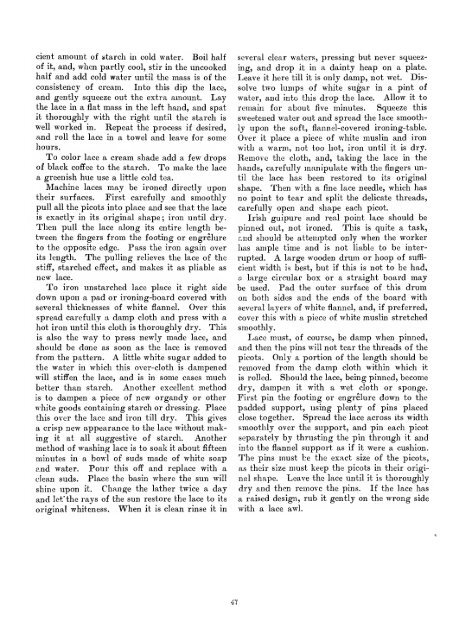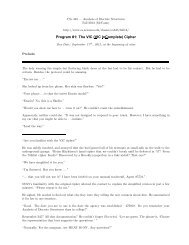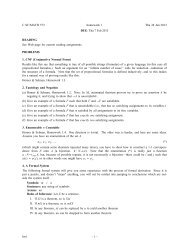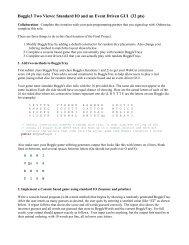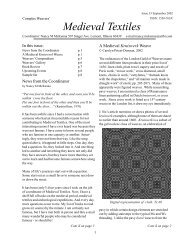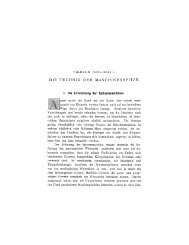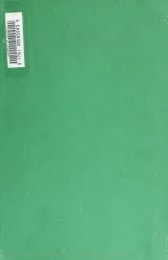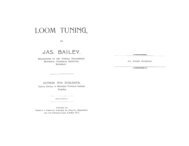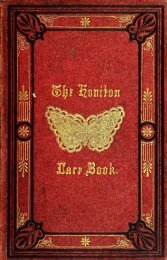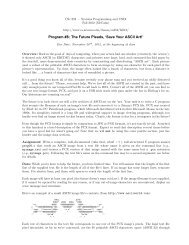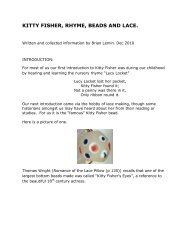The Priscilla Battenberg and point lace book; a collection of lace ...
The Priscilla Battenberg and point lace book; a collection of lace ...
The Priscilla Battenberg and point lace book; a collection of lace ...
Create successful ePaper yourself
Turn your PDF publications into a flip-book with our unique Google optimized e-Paper software.
cient amount <strong>of</strong> starch in cold water. Boil half<br />
<strong>of</strong> it, <strong>and</strong>, when partly cool, stir in the uncooked<br />
half <strong>and</strong> add cold water until the mass is <strong>of</strong> the<br />
consistency <strong>of</strong> cream. Into this dip the <strong>lace</strong>,<br />
<strong>and</strong> gently squeeze out the extra amount. Lay<br />
the <strong>lace</strong> in a flat mass in the left h<strong>and</strong>, <strong>and</strong> spat<br />
it thoroughly with the right until the starch is<br />
well worked in. Repeat the process if desired,<br />
<strong>and</strong> roll the <strong>lace</strong> in a towel <strong>and</strong> leave for some<br />
hours.<br />
To color <strong>lace</strong> a cream shade add a few drops<br />
<strong>of</strong> black c<strong>of</strong>fee to the starch. To make the <strong>lace</strong><br />
a greenish hue use a little cold tea.<br />
Machine <strong>lace</strong>s may be ironed directly upon<br />
their surfaces. First carefully <strong>and</strong> smoothly<br />
pull all the picots into p<strong>lace</strong> <strong>and</strong> see that the <strong>lace</strong><br />
is exactly in its original shape; iron until dry.<br />
<strong>The</strong>n pull the <strong>lace</strong> along its entire length between<br />
the fingers from the footing or engrelure<br />
to the opposite edge. Pass the iron again over<br />
its length. <strong>The</strong> pulling relieves the <strong>lace</strong> <strong>of</strong> the<br />
stiff, starched effect, <strong>and</strong> makes it as pliable as<br />
new <strong>lace</strong>.<br />
To iron unstarched <strong>lace</strong> p<strong>lace</strong> it right side<br />
down upon a pad or ironing-board covered with<br />
several thicknesses <strong>of</strong> white flannel. Over this<br />
spread carefully a damp cloth <strong>and</strong> press with a<br />
hot iron until this cloth is thoroughly dry. This<br />
is also the way to press newly made <strong>lace</strong>, <strong>and</strong><br />
should be done as soon as the <strong>lace</strong> is removed<br />
from the pattern. A little white sugar added to<br />
the water in which this over-cloth is dampened<br />
will stiffen the <strong>lace</strong>, <strong>and</strong> is in some cases much<br />
better than starch. Another excellent method<br />
is to dampen a piece <strong>of</strong> new org<strong>and</strong>y or other<br />
white goods containing starch or dressing. P<strong>lace</strong><br />
this over the <strong>lace</strong> <strong>and</strong> iron till dry. This gives<br />
a crisp new appearance to the <strong>lace</strong> without making<br />
it at all suggestive <strong>of</strong> starch. Another<br />
method <strong>of</strong> washing <strong>lace</strong> is to soak it about fifteen<br />
minutes in a bowl <strong>of</strong> suds made <strong>of</strong> white soap<br />
<strong>and</strong> water. Pour this <strong>of</strong>f <strong>and</strong> rep<strong>lace</strong> with a<br />
clean suds. P<strong>lace</strong> the basin where the sun will<br />
shine upon it. Change the lather twice a day<br />
<strong>and</strong> let' the rays <strong>of</strong> the sun restore the <strong>lace</strong> to its<br />
original whiteness. When it is clean rinse it in<br />
4T<br />
several clear waters, pressing but never squeez-<br />
ing, <strong>and</strong> drop it in a dainty heap on a plate.<br />
Leave it here till it is only damp, not wet. Dis-<br />
solve two lumps <strong>of</strong> white su^ar in a pint <strong>of</strong><br />
water, <strong>and</strong> into this drop the <strong>lace</strong>. Allow it to<br />
remain for about five minutes. Squeeze this<br />
sweetened water out <strong>and</strong> spread the <strong>lace</strong> smooth-<br />
ly upon the s<strong>of</strong>t, flannel-covered ironing-table.<br />
Over it p<strong>lace</strong> a piece <strong>of</strong> white muslin <strong>and</strong> iron<br />
with a warm, not too hot, iron until it is dry.<br />
Remove the cloth, <strong>and</strong>, taking the <strong>lace</strong> in the<br />
h<strong>and</strong>s, carefully manipulate with the fingers un-<br />
til the <strong>lace</strong> has been restored to its original<br />
shape. <strong>The</strong>n with a fine <strong>lace</strong> needle, which has<br />
no <strong>point</strong> to tear <strong>and</strong> split the delicate threads,<br />
carefully open <strong>and</strong> shape each picot.<br />
Irish guipure <strong>and</strong> real <strong>point</strong> <strong>lace</strong> should be<br />
pinned out, not ironed. This is quite a task,<br />
r.nd should be attempted only when the worker<br />
has ample time <strong>and</strong> is not liable to be inter-<br />
rupted. A large wooden drum or hoop <strong>of</strong> suffi-<br />
cient width is best, but if this is not to be had,<br />
a large circular box or a straight board may<br />
be used. Pad the outer surface <strong>of</strong> this drum<br />
on both sides <strong>and</strong> the ends <strong>of</strong> the board with<br />
several layers <strong>of</strong> white fiannel, <strong>and</strong>, if preferred,<br />
cover this with a piece <strong>of</strong> white muslin stretched<br />
smoothly.<br />
I^ace must, <strong>of</strong> course, be damp when pinned,<br />
<strong>and</strong> then the pins will not tear the threads <strong>of</strong> the<br />
picots. Only a portion <strong>of</strong> the length should be<br />
removed from the damp cloth within which it<br />
is rolled. Should the <strong>lace</strong>, being pinned, become<br />
dry, dampen it with a wet cloth or sponge.<br />
First pin the footing or engrelure down to the<br />
padded support, using plenty <strong>of</strong> pins p<strong>lace</strong>d<br />
close together. Spread the <strong>lace</strong> across its width<br />
smoothly over the support, <strong>and</strong> pin each picot<br />
separately by thrusting the pin through it <strong>and</strong><br />
into the flannel support as if it were a cushion.<br />
<strong>The</strong> pins must be the exact size <strong>of</strong> the picots,<br />
as their size must keep the picots in their original<br />
shape. Leave the <strong>lace</strong> until it is thoroughly<br />
dry <strong>and</strong> then remove the pins. If the <strong>lace</strong> has<br />
a raised design, rub it gently on the wrong side<br />
with a <strong>lace</strong> awl.


